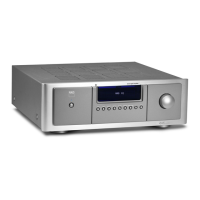Pulse Width Correction actively adjusts the pulse width (PCM to PWM conversion) to compensate for amplier
non-linearity.
Power Supply Feedback is a scheme where the power supply voltage is monitored and the amplier gain is adjusted,
compensating for pulse amplitude errors.
Pre-correction is a static compensation for known amplier non-linearities.
Direct Digital Feedback operates simply by determining the pulse area error, no matter what the cause, and passing this
information back to the digital domain where compensation can be made. This method calls for all distortion mechanisms
regardless of their source.
The New Frontier
As proven by our recent Masters Series ampliers (M3, M25), NAD has brought the performance of the Linear Class AB
amplier very close to theoretical perfection. The next frontier for improved performance is the digital amplier.
Now the M2 provides a benchmark for performance, both measured and subjective, in the new world of digital
amplication. Highly efcient, immensely powerful and musically revealing and involving, the M2 Direct Digital Amplier
takes its place among the world’s best ampliers regardless of price or design philosophy.
But for a digital amplier implementing this simple concept is anything but simple! As we have pointed out, the M2 takes
a digital input signal and outputs an analogue signal to drive the loudspeaker.
The conventional feedback architecture with a loop from the output to the amplier’s input is too slow and not a successful
approach with a digital amplier, so the direct digital feedback technology was developed to deliver the solution.
A feedback error signal is generated by comparing an extremely pure PWM reference and then converts to the digital
domain for digital correction. This loop correction, occurring once every 9 trillions of a second, assures the highest levels
of speed and accuracy. This very direct feedback approach is at the heart of the M2 architecture.
Some limited forms of feedback have been used successfully before in PWM-based amps. The common problems
with digital amplication and the various solutions are shown in the table below:

